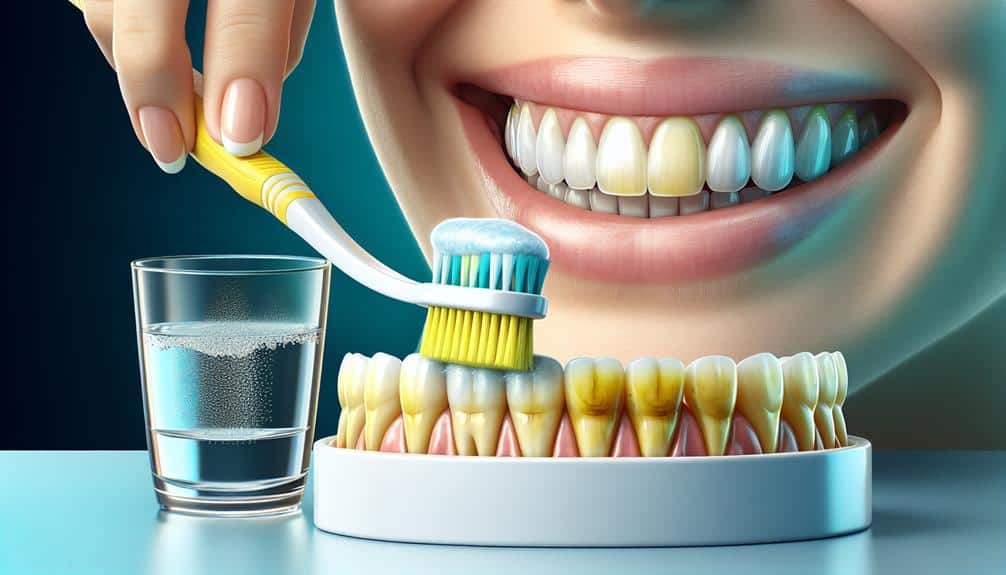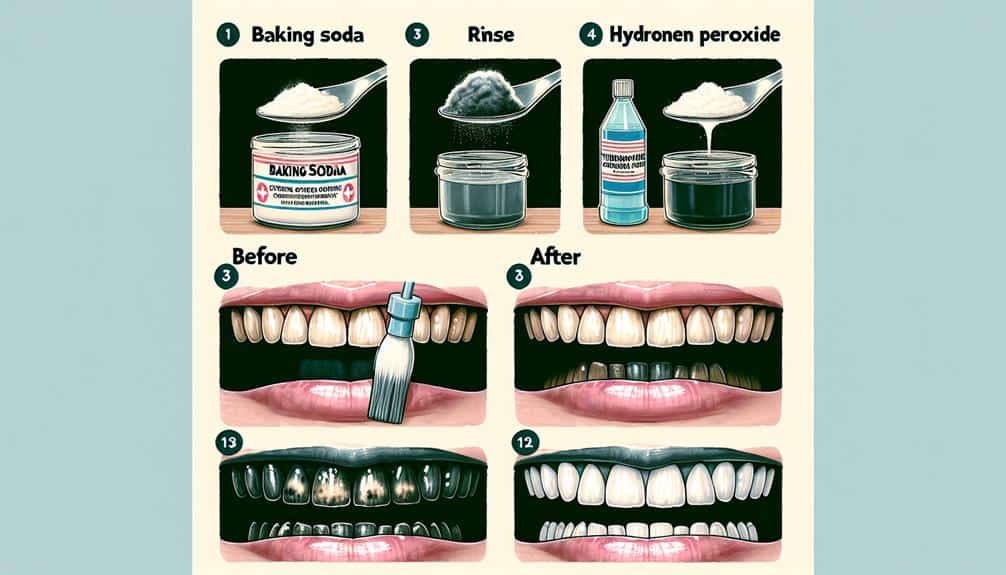To effectively whiten tetracycline-stained teeth, consider professional treatments for immediate results. Expert supervision guarantees safety and deep stain targeting with high-concentration gels. Home kits require careful use and customized trays for best coverage. Natural remedies like oil pulling and herbal options can gently whiten teeth. Maintain results by avoiding staining beverages, using whitening fluoride toothpaste, and scheduling regular cleanings. Enhance your smile with proven techniques.
Key Points
- Consult a dental professional for personalized whitening recommendations.
- Consider in-office bleaching for immediate and monitored results.
- Use at-home whitening kits diligently to avoid enamel damage.
- Explore natural remedies like oil pulling or baking soda paste.
- Maintain results with proper oral hygiene and regular dental visits.
Understanding Tetracycline-Stained Teeth
Understanding Tetracycline-Stained Teeth can be intricate due to the unique way in which the antibiotic tetracycline binds to dental enamel during tooth development. Tetracycline, when ingested during childhood, becomes incorporated into the structure of developing teeth, leading to intrinsic staining that ranges from light yellow to dark gray or brown. The severity of staining is influenced by factors such as the dosage and duration of tetracycline exposure.
Causes of tetracycline staining include the timing of antibiotic administration during tooth development and the specific type of tetracycline used. Prevention of tetracycline staining primarily involves avoiding the use of tetracycline antibiotics during pregnancy and in children under the age of eight, as this is the critical period for tooth development. Additionally, dentists must carefully consider alternative antibiotics for pregnant women and young children to prevent the risk of tetracycline staining. Understanding these causes and prevention strategies is essential for managing tetracycline-stained teeth effectively.
Professional Whitening Options
To effectively address tetracycline-stained teeth, professional whitening options offer a reliable solution for improving the appearance of intrinsic discoloration caused by the antibiotic. In-office treatments conducted by dental professionals are a popular choice for individuals seeking more immediate and noticeable results. These procedures often involve bleaching techniques that are carefully monitored to guarantee the safety and effectiveness of the whitening process.
During in-office whitening sessions, dentists use high-concentration bleaching gels or other products to target the deep-set stains characteristic of tetracycline discoloration. The advantage of professional treatments lies in the expertise of the dental team, who can tailor the procedure to suit the individual's specific needs while minimizing the risk of adverse effects.
At-Home Whitening Kits
For individuals looking to continue their teeth whitening efforts at home, exploring the use of at-home whitening kits can be a convenient and accessible option following professional treatments for tetracycline-stained teeth. Here are some insider tips to make the most out of at-home whitening kits:
- Consistency is Key: Follow the instructions provided with the kit diligently to achieve the best results.
- Avoid Overuse: While you may be enthusiastic to see quick results, overusing whitening kits can harm your enamel.
- Consider Customized Options: Some kits offer custom trays for a more precise fit and better whitening coverage.
- Maintain Oral Health: Brush and floss regularly, and consider using a desensitizing toothpaste if you experience sensitivity.
When using at-home whitening kits, always be cautious and patient. If you're unsure about which kit to choose or how to proceed, consult your dentist for personalized recommendations.
Natural Remedies for Whitening
Try incorporating natural remedies into your teeth whitening routine to explore alternative and potentially effective methods for brightening your smile. DIY solutions offer a range of herbal alternatives that can help whiten tetracycline-stained teeth. One popular method is oil pulling, where swishing coconut or sesame oil in your mouth for 15-20 minutes daily may help remove surface stains. Baking soda mixed with a small amount of water to form a paste is another DIY solution that can gently scrub away stains. Additionally, rubbing orange peel on your teeth or creating a paste with strawberries and baking soda are natural alternatives believed to have whitening properties.
Herbal remedies like sage, thyme, and turmeric have also been suggested for their potential teeth-whitening effects. Sage and thyme can be made into a paste with water and applied to the teeth for a few minutes before rinsing. Turmeric, when mixed with coconut oil into a paste, may help brighten teeth due to its natural whitening properties. Incorporating these natural remedies into your routine can provide a gentle and chemical-free approach to whitening your teeth.
Maintenance Tips for Lasting Results
For long-lasting results in maintaining whitened teeth, consistent oral hygiene practices are crucial. To guarantee your tetracycline-stained teeth stay bright, follow these maintenance tips:
- Diet Restrictions: Avoid consuming staining agents like coffee, tea, red wine, and colored foods. Opt for a straw when drinking dark beverages to minimize contact with your teeth.
- Proper Oral Hygiene: Brush your teeth at least twice a day with a whitening toothpaste containing fluoride. Floss daily to remove plaque and prevent stains between teeth.
- Regular Dental Visits: Schedule bi-annual dental cleanings to remove surface stains and monitor the health of your teeth.
- Touch-Up Treatments: Consider occasional touch-up whitening treatments at your dentist's office to maintain the brightness of your teeth.
Frequently Asked Questions
Are There Any Potential Risks or Side Effects Associated With Whitening Tetracycline-Stained Teeth That Patients Should Be Aware Of?
Do you wonder about potential risks or side effects when whitening tetracycline-stained teeth? It's important to know these before starting. Risks may include temporary tooth sensitivity or gum irritation, while treatment duration varies for noticeable results.
How Long Does the Whitening Process Typically Take to See Noticeable Results on Tetracycline-Stained Teeth?
To see noticeable results on tetracycline-stained teeth, the whitening process typically takes a few weeks. Consistency is key. After achieving desired results, maintain by avoiding staining foods and beverages, and follow your dentist's recommendations for touch-up treatments.
Can Tetracycline-Stained Teeth Be Effectively Whitened if the Staining Is Severe or Has Been Present for a Long Time?
When addressing severe and long-standing tetracycline stains, the efficacy of whitening procedures may vary. Consultation with a dental professional is crucial for personalized advice on the optimal course of action for your particular situation.
Are There Any Specific Dietary or Lifestyle Changes That Can Help Maintain the Results of Whitening Tetracycline-Stained Teeth?
To maintain your brightened tetracycline-stained teeth, focus on your dietary habits and oral hygiene. Avoid staining foods like coffee and red wine, brush and floss regularly, and consider touch-up treatments as needed. Embrace lifestyle changes for lasting results.
Are There Any Alternative Treatments or Procedures Available for Whitening Tetracycline-Stained Teeth Besides Professional Whitening Options or At-Home Kits?
Seeking alternative treatments for whitening tetracycline-stained teeth? Consider natural remedies like oil pulling, baking soda, or activated charcoal. While not as potent as professional options, they offer gentler alternatives worth exploring.



